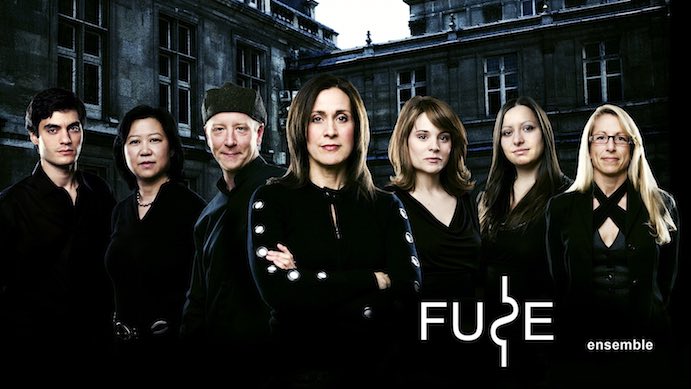3: The Music of Gina Biver (Ravello Records) begins with Gina Biver herself, speaking directly in front of you: “Something looks back each time I move/Oh, demon mask/Sad, turned down mouth.” The opening track, Mirror, feels intimate, as if you are in the front row of a small venue, Biver just feet away, brooding and biting as she speaks the poetry of Colette Inez.
The immediacy of this close, dark setting lays the groundwork for Fuse Ensemble’s newest album. 3: The Music of Gina Biver explores identity: how much of our identity is conscious, how much of it do we actually control? Of course, the exploration of identity in music is not an uncommon one, but Biver’s take on these questions feels fresh and compelling, especially due to her audio engineering chops throughout the album. A producer as well as a composer, Biver is able to place voices, found sounds, and acoustic instruments alike into distinct and intentional listening space in order to drive her ideas home.
Biver’s audio engineering shines brightest on the album’s penultimate track, The Cellar Door. The piece is enjoyable even without knowing its intended meaning; it feels sinister right from the get-go, comprised of what sounds like a mellow jazz pianist jamming while a horror movie soundtrack plays itself out underneath. But once you fold Biver’s intent into the listening experience, the execution of the piece becomes all the more brilliant. According to Biver’s album notes,“The audio track represents the unconscious…the piano and cello represent the conscious life.” With this in mind, the two layers in The Cellar Door take on new meaning. Through her audio mixing, Biver creates a three-dimensional listening experience, in which layers move from side to side and front to back, playing with the listener’s focus.

This 3D listening experience is, surprisingly, quite useful for portraying ideas about consciousness and unconsciousness. In the middle of the piece, as the “conscious” jazz piano becomes stuck on one particularly dissonant motif. Meanwhile, the “unconscious” audio track churns, booms, and vibrates in the background. As this repetition continues, one becomes so fixated on the creaking that it is easy to miss the piano dropping out altogether, leaving only the “unconscious” layer, wailing with its rusty, metallic refrain.
What does it say about our minds that, upon first listen, Biver’s “unconscious life” layer sounds like a horror movie soundtrack? What does it say about our daily existence that the “conscious life” layer often feels as if it gets stuck, repeating the same motif over and over in an attempt to break free? In experimenting with the placement of her audio, pushing the placement of the conscious and unconscious, Biver creates a playground for internal exploration that is both fascinating and deeply effective.
This clever audio manipulation appears throughout the entire album, always enhancing and clarifying Biver’s compositional intent. In We Meet Ourselves, Scott Deal’s bouncing and playful marimba lives at the forefront in terms of volume, and yet, once Deal begins to incorporate the triggered audio elements, the marimba falls to the background as the listener strains to hear the electronic voice elements popping in unexpectedly–Biver’s way of conveying “the [unconscious] messages we receive as we go through life.”

In Girl Walking, Biver manipulates foreground and background to portray the idea that while certain elements of our identity shift and grow and evolve, others are ever-present. The piece begins with a light and airy (but still menacing) electric guitar motif (Biver). A flute line (Jennifer Lapple) makes its way into the foreground, slowly becoming more violent and spastic as the underlying guitar fades into the background. The piece oscillates between different lives, from meditative and dreary to violent and struggling to mellow and groovy. At times, these lives intersect: in the midst of funky guitar licks, meditative chimes (Deal) suddenly appear. But throughout all of these changes, the electric guitar is almost always somewhere in the mix, eerily strumming underneath it all.
The last piece on the album, No Matter Where, stands out as the only track that does not address questions of identity or consciousness. Beginning with ambient train chugging, chromatic and dissonant lines on violin (Greg Hiser), piano (Ina Mirtcheva), and clarinet (Angela Murakami) eventually weave together to create a familiar contemporary sound–but then, Biver works her magic. A quiet tapping pattern emerges in the background, pulled from the train audio, and suddenly the instruments’ pounding repeated line hits a subtle groove, working in accordance with the train’s taps. These layers mesh, unravel, and mesh again, eventually giving way to a simple ending, one that lives in contrast to the darker, more dissonant sounds present throughout the album. With its use of plucked strings and bright piano, the ending is light, plunky, almost childish.
The best of Biver’s music lies in the layers; the moments where one instrument feels too close, or too separate, or where the listener questions whether the tapping and clicking audio tracks are coming from the album or from somewhere outside. Fuse Ensemble’s 3: The Music of Gina Biver demonstrates the enormous possibilities that come with composer-engineer crossovers–and it is just so much fun to listen to.
























